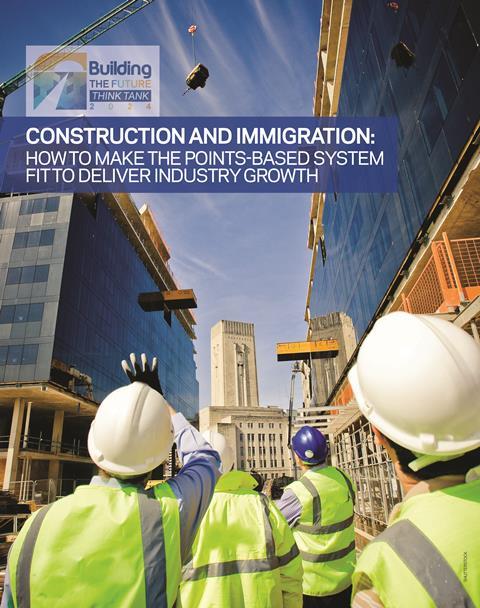In an in-depth report published by the ║├╔½Ž╚╔·TV the Future Think Tank this week, we look at how Brexit has changed the way we recruit foreign workers ŌĆō and the implications of that decision. Read the second part of our analysis today

This week the ║├╔½Ž╚╔·TV the Future Think Tank is serialising its 15-page report looking in depth at the current immigration system and its impact on the construction industry. Over five days we will set out the case for reform, culminating in a set of recommendations.
In todayŌĆÖs article, we look at the previous system, the implications for construction of the vote to leave the EU in 2016 and how the industry has had to change its ways of working.
Staffing the industry prior to Brexit
Before the referendum, and for a considerable time afterwards, EU citizens had an unrestricted, unlimited right to live and work in the UK under freedom of movement rules. Given that controversy over the number of EU migrants, especially from accession state countries, had played a large part in the campaigning around the Brexit vote, it was apparent after the referendum that the mandate to ŌĆ£take back controlŌĆØ was likely to result ultimately in the ending of freedom of movement.
At the date of the referendum in June 2016, official figures suggest there were 2.24 million people working in the UK construction industry ŌĆō very close to the level today. This was 200,000 above the trough in the labour force seen in 2008-10 in the wake of the global financial crisis, and more than 100,000 below the peak in employment seen in 2019, shortly before the onset of the covid pandemic.
In the years leading up to the referendum, the construction industry had rapidly expanded its use of overseas workers in response to perceived skills shortages and an apparently keen pool of available workers from new EU member states that had formerly been part of the Eastern Bloc, many of which joined in 2004.

>> Also read: Introduction: why the immigration system needs reform for construction to flourish
The EU principle of freedom of movement guaranteed EU citizens the right to work in the UK, regardless of their nationality. While transitional provisions that restricted the rights of Bulgarians and Romanians to work in the UK were initially applied after they subsequently joined in 2007, after 2014 those countries benefited from full freedom of movement too.
In contrast, the UK at the time operated a relatively strict, tiered immigration policy for migrants from outside the EU, with applicants subject to a version of todayŌĆÖs points-based system. The issuing of visas was subject to a cap on numbers, and employers looking to take on non-EU staff would have to pass a ŌĆ£resident labour market testŌĆØ to ensure that no UK person was available to do the role instead.
Use of migrant workers
According to research on the impact of free movement undertaken by the National Institute of Economic and Social Research and published in 2016, the proportion of foreign-born workers in the construction industry doubled between 2004 and 2014, to make up 12% of the 2.1 million workforce at that time. This growth, the research said, was mainly a result of workers coming from new EU member states.
The same research, which of course pre-dated Brexit, also revealed how concentrated the migrant workforce was. It found that in London 54% of construction workers were migrants; and in the South-east and East of England, the regions recording the next-highest proportion, migrant workers accounted for 9% of the workforce. However, the proportion of migrants in the construction workforce in many parts of the country remained as low as 2% to 3%.
Just before the 2016 Brexit vote, economic growth spurred by a Help to Buy-fuelled recovery in the housing market and infrastructure investment meant the Construction Industry Training Board was estimating that 46,420 new staff would have to be trained each year to keep pace with projected growth, with the body citing labour shortages seen by trade organisations such as the Civil Engineering Contractors Association. In the same year, Mark FarmerŌĆÖs Modernise or Die report referenced an impending ŌĆ£ticking time bombŌĆØ of ageing workers leaving the industry, with no prospect of enough new joiners being trained to replace them.
FarmerŌĆÖs report said the industryŌĆÖs demographic challenge meant UK construction faced a ŌĆ£capacity shrinkage that would render the industry incapable of delivering the levels of GDP historically seenŌĆØ and which would ŌĆ£undermine the UKŌĆÖs ability to deliver critical social and physical infrastructure, homes and built assetsŌĆØ. He noted that the Brexit vote meant the UKŌĆÖs ability to meet this demand for workers via expanding migration was ŌĆ£now uncertainŌĆØ.
In our survey of ║├╔½Ž╚╔·TV readers for this report, 71% of those who expressed a view said the industry ŌĆ£depended on EU workers to function effectively prior to the introduction of the points-based immigration system in December 2020ŌĆØ. Members of ║├╔½Ž╚╔·TVŌĆÖs advisory panel said this ability had provided a ŌĆ£vital flexibility within the labour forceŌĆØ.
Industry structure
The industry has typically been staffed with a relatively high proportion of self-employed workers, which is commonly seen as a by-product of the unreliability of the workload, alongside vertical fragmentation of supply chains. Given the relatively high likelihood of construction projects being paused or cancelled, and the often uneven nature of the pipeline, many contractors have preferred to limit the number of payrolled permanent staff, supplementing their in-house skills with labourers or tradespeople working on a self-employed and temporary basis. Official statistics suggest that at the time of the Brexit vote, 61% of the construction workforce were employed on a payroll basis, while 39% were self-employed.
Furthermore, data from the CITB shows that the majority (57%) of construction trade occupation workers remain self-employed. In many occupations the figure is higher, with 82% of plasterers, 76% of bricklayers, 70% of carpenters and joiners and 66% of roofers self-employed. Only one in every 500 businesses in construction is medium or large (defined as having more than 49 employees).
Where EU staff were used on sites prior to Brexit, there is evidence to suggest many were self-employed. Figures from the 2017 Annual Population Survey, cited by the Migration Advisory Council, show 40% of all self-employed workers from the European Economic Area operating in the UK at that time were in various parts of the construction sector, with around a third identifying as carrying out construction trades. In our survey, around half of those who expressed a view said EU workers in the UK pre-Brexit were more likely than UK-born staff to be hired on a self-employed basis.
Professional skills
But it was not just site and trade skilled staff who were coming over from the EU to work in the UK. EU staff played a major role in construction professions prior to Brexit. EU nationals, for example, made up around 25% of the registered architects living in the UK at the time of the vote, according to the RIBA, with the architectsŌĆÖ body seeing EU expertise as a key contributor to the success of the profession in the UK.
How we compiled our report

A survey on key topics was sent out to ║├╔½Ž╚╔·TV subscribers, which was completed by around 130 consultants, contractors and specialists ŌĆō as well as others in academia, government and developers. This survey formed a key part of the evidence base for the views of the sector, alongside a desk review of literature on the subject.
In addition, a core group of advisers ŌĆō the ║├╔½Ž╚╔·TV the Future Think Tank advisory panel ŌĆō participated in two roundtable discussions to further develop the themes and ideas in this report.
The feedback from both forums, along with the literature review and the subscriber survey, contributed to the conclusions and recommendations ultimately arrived at. However, the views expressed in the report are those of the author and ║├╔½Ž╚╔·TV magazine alone, and participants cannot be assumed to have endorsed the final findings.
We are hugely appreciative of the input given by the ║├╔½Ž╚╔·TV the Future Think Tank advisory panel members. These were:
- David Barnes, head of policy and public affairs, Chartered Institute of ║├╔½Ž╚╔·TV
- David Bishop, project director, Build UK n James Butcher, director of strategy and operations, National Federation of Builders n Mark Farmer, chief executive, Cast, and government-appointed independent lead reviewer for the armŌĆÖs-length body review of industry training boards
- Iain Lindsay, head of talent, John Sisk & Son n Phoebe MacDonald, head of policy and public affairs, RIBA
- Laura Markus, policy and external affairs manager, Home Builders Federation
- Tom Mayhew, partner, Simons Muirhead Burton
- Marley Morris, associate director ŌĆō migration, trade and communities, Institute for Public Policy Research
- Alasdair Reisner, chief executive, Civil Engineering Contractors Association
- Heather Rolfe, director of research and relationships, British Future
- Daliah Sklar, chief executive, founder and UK immigration expert solicitor solicitor, DRSI Borderless Jobs
- Gary Sullivan, chair, Wilson James
- Rico Wojtulewicz, head of policy and market insight, National Federation of Builders
The new policy environment
Boris JohnsonŌĆÖs Conservative party won the December 2019 election with a mandate to ŌĆ£get Brexit doneŌĆØ. However, the manifesto also, more specifically, promised to introduce what it called a ŌĆ£firmer and fairer Australian-style points-based immigration systemŌĆØ. This, it said, would end freedom of movement, limit access to the UK for low-skilled workers, and ensure ŌĆ£we can decide who comes to this country on the basis of the skills they have and the contribution they can makeŌĆØ.
Despite the intervention of the covid crisis, JohnsonŌĆÖs government ensured that this new points-based immigration system was indeed up and running from 1 December 2020. Shortly afterwards, on 31 December, EU freedom of movement ended in the UK ŌĆō 11 months after the UKŌĆÖs formal departure from the union in January of the same year.
Freedom of movement had allowed all EU citizens the right to live and work in the UK, regardless of nationality. At the same time relatively tight controls had operated on immigration from outside the EU.
Principles of the points-based system
While the points-based system has been tweaked several times since its launch, the operating principles of the system for managing those looking to move to the UK for work remain as they were set out at launch. These are:
- Equal treatment for EU and non-EU workers
- A tradeable points-based system for skilled workers to qualify, so long as core criteria are met
- A requirement for the worker to be brought in by a sponsor employer (no self-employment route)
- Job listed on the skilled occupations list
- Core criteria including a minimum English language requirement
- Other requirements, such as minimum salary levels, that can be traded to reach the required points score for approval if occupations are deemed to be in particularly high demand, or if the applicant is particularly highly qualified.
Setting up the system involved in effect converting the previously operating ŌĆ£tier 2 (general)ŌĆØ visa route for non-EU workers into the new points-based system, and rebranding it as the skilled worker visa, by which the vast majority of potential migrant workers could hope to enter the UK.
The system explicitly ŌĆō and deliberately ŌĆō ruled out allowing a route for low-skilled migrants to work in the UK.
Migrants can work in the UK through the points-based system only when sponsored by an approved employer, so not on a self-employed basis. When the system was introduced, the general minimum annual salary threshold set for the skilled worker route under the points-based system was ┬Ż25,600, although role-specific salary thresholds applied to many occupations.
Those using the skilled worker visa system are subject to various charges. Employers have to pay an immigration skills charge (dependent on company size) per worker of up to ┬Ż1,000 in the first year and then ┬Ż500 for subsequent years. Migrants themselves will usually have to pay an application fee of up to ┬Ż1,639 plus a ┬Ż1,035 annual healthcare surcharge, and have a further ┬Ż1,270 available to support themselves when they arrive in the UK.
Comparison to previous system
The previous tier 2 (general) visa had operated in a broadly similar fashion for non-EU workers, but with significantly greater restrictions than the new points-based system. The skill level expected under the tier 2 visa was higher, with only migrants in occupations demanding Regulated Qualifications Framework (RQF) level 6 qualifications (equivalent to an honours degree) allowed in, whereas the new skilled worker visa sets the bar at RQF level 3 (equivalent to A-levels or apprenticeships), meaning that skilled trade occupations qualify.
In addition, the government ŌĆō initially, that is ŌĆō set the salary bar lower than under the tier 2 visa, which had been ┬Ż30,000 a year.
Most significantly, the government decided to ditch the caps on migrant numbers and the resident labour market test (which required employers to first advertise a post domestically), which had both operated under the tier 2 visa.
As a result, while the introduction of the points-based system meant a huge reduction in the ability of employers to hire staff from the EU, it represented a significant relaxation of the rules for employers hiring workers from the rest of the world.
Madeleine Sumption, director of the Migration Observatory at the University of Oxford, said at the time that the scheme was first announced that the requirements ŌĆ£are lower than they were for non-EU citizens under the pre-2021 immigration rules [ŌĆ”] As a result, the new system represents a liberalisation for non-EU citizens.
ŌĆ£For EU citizens, on the other hand, the new system greatly reduces options for legal labour migration, effectively shutting out a large range of employers in low-wage industries from hiring EU citizens.ŌĆØ
From the perspective of the construction industry, the skilled worker visa offers the theoretical potential for a huge range of construction workers to be brought in. Occupations listed as providing eligibility for the skilled worker visa include professional roles such as architect, planner, engineer, project manager and surveyor, alongside skilled trades jobs such as plasterer, plumber, roofer, bricklayer and tiler, along with building foreman, general builder, developer and building company owner. The government keeps a full list online (under the heading ŌĆ£Skilled worker visa: eligible occupations and codesŌĆØ).
Shortage occupations
As well as listing qualifying skilled occupations, the government has identified a number of ŌĆ£shortage occupationsŌĆØ where demand for workers is deemed to be particularly high.
At the time of the introduction of the points-based system, applicants for roles on what was then called the shortage occupation list were able to qualify for entry to the UK with a salary of just ┬Ż20,480, or 80% of the going rate for a specific occupation. This was part of the idea of trading different qualities referenced in the naming of the points-based system.
In March 2023 the Migration Advisory Council, which advises the government on what to include on the shortage occupation list, told the government to include bricklayers and masons; roofers, roof tilers and slaters; carpenters and joiners; construction and building trades (not elsewhere classified); and plasterers and dryliners. These occupations were added in September 2023.
Recent changes
Since the system was introduced, it has been tweaked several times and, most recently, tightened up significantly. In December 2023, then home secretary James Cleverly announced changes to the skilled worker visa route, including raising the general minimum salary threshold from ┬Ż26,200 to ┬Ż38,700 a year, and raising other, occupation-specific salary thresholds from the first quartile to the 50th percentile of the going rate for the relevant role.
At the same time, the government announced reform of the shortage occupation list, which it at that point renamed the immigration salary list. This included removing the 20% discount on the salary requirement for those occupations.
After a rapid review commissioned by the Home Office, carried out without engagement from business, the Migration Advisory Committee concluded that only 21 occupations should have a place on the new immigration salary list, a much reduced number from the previous shortage occupation list. However, the committee recommended that stonemasons, bricklayers, roofers, roof tilers, slaters, carpenters and building retrofitters should nevertheless be included, while plasterers were removed. These changes were introduced in April 2024.

Read the rest of our report in further instalments
TodayŌĆÖs article is the second in a series looking in depth at the current immigration system. Over the coming days we set out the case for reform:
- On ║├╔½Ž╚╔·TV yesterday: Introduction: why the immigration system needs reform
- Tomorrow: Chapter 3: How the new settlement has bedded in
- On Thursday Chapter 4: Why the new system is not working
- On Friday: Chapter 5: How the new system can be reformed and recommendations for change
At our conference on 18th September we will release the full 15-page report, which will be available as a downloadable pdf.
The ║├╔½Ž╚╔·TV the Future Think Tank is our research hub producing indepth research on behalf of the industry. Last year we published three major reports into ways to shape a better built environment, more research will be published later this month.

║├╔½Ž╚╔·TV the Future Conference is back ŌĆ” at Church House, London, 18 September

The ║├╔½Ž╚╔·TV the Future Conference is set to return to central London on 18 September, bringing together leading industry experts to unpack the biggest issues facing the built environment.
Keynote speakers include Mark Robinson, chief executive, Scape Group, and Eoghan OŌĆÖLionaird, chief executive, Wates.
Our panel sessions focus on net zero, building safety and driving productivity on construction projects. They will be fully interactive, allowing you the chance to have your say, and put your questions to any of our expert speakers.
For attendees we will be launching three more research reports linked to the themes of the conference.


























No comments yet